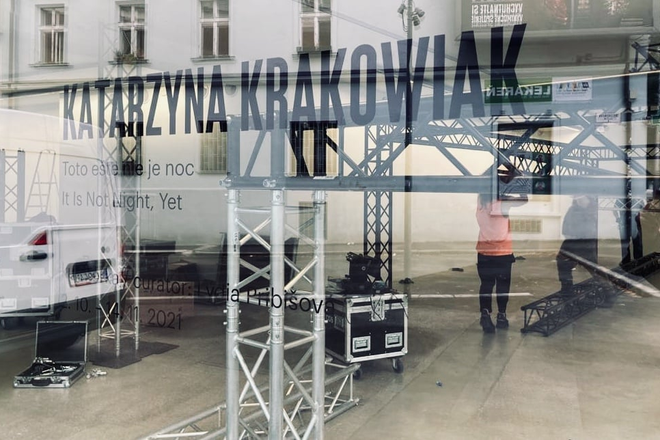Thousands of people are laughing out loud in Bratislava’s Kunsthalle exhibition space.
If one ever wonders how so many people can be squeezed into such a small space, it is by no means rocket science. It is a recording conveying this explosion of laughter, to which people from around the world contributed.
It Is Not Night, Yet by Katarzyna Krakowiak
Venue: Kunsthalle Bratislava
Date: until November 14
Opening hours: Monday-Sunday from 12:00 to 19:00 (closed on Tuesday)
Admission: voluntary
“They created one concerted voice speaking out against injustice, exclusion and oppression,” said curator Lýdia Pribišová on the artwork by Polish artist Katarzyna Krakowiak.
The It Is Not Night, Yet social acoustic sculpture is being displayed at Kunsthalle until November 14 to express solidarity and support for women whose rights are nowadays more and more denied.
Sound bridge
Krakowiak created a similar work last year in Barcelona, which she called It Begins with One Word. Choose Your Own, to reflect a world under lockdown. The artist then asked people to submit words that they wished to be everlasting. Krakowiak went on to create a polyphonic composition from them.

“In Bratislava, she created a monumental sound bridge uniting people in order to let emotions flow freely,” Pribišová said. “It is precisely what we need at a time of crisis, when rights are trodden underfoot, and freedoms violated.”
In addition to collective power, Krakowiak’s installation broadcasts a powerful message of hope.
However, it is not just loudness that matters to the Polish artist. Silence is also important as reflected in her 2016 If Nothing Could Fall but The Sun work exhibited around Europe, and she worked with silence on her Bratislava installation.
Katarzyna Krakowiak (1980):
lives and works in Otwock in Poland and Oliva in Spain;
leads the Studio of Sound Activities at the Academy of Fine Arts in Warsaw;
exhibited all over Europe, in the USA, and Mexico;
gained particular recognition in 2012 for her work 'The Walls Quake as if They Were Dilating with the Secret Knowledge of the Great Powers,' in the Polish pavilion at the 13th international exhibition of architecture in Venice.
“Laughter emerges from silence, inconspicuously bubbling up and gradually increasing in loudness,” explained Pribišová.
She added that Krakowiak’s work could be interpreted in many ways, both positive and negative.
Laughter becomes architecture
The artist is often inspired by architecture, giving different spaces a voice through sounds. Almost a decade ago in New York City, she created an installation in a massive but mostly empty post office building in the crowded Manhattan area.
“She led visitors through empty rooms and corridors, which she revived with sounds typical of a post office, linking the past and the present,” Pribišová said.
As for her latest project in Bratislava, she was inspired by Kunsthalle’s central position within the city, with several institutions nearby, including a hospital, an old market hall, the Polish Institute, and a ministry.
“Krakowiak plays a game with sound, ‘sonifies’ hidden aerial trajectories, seeks points of relation; laughter here becomes architecture, a bridge,” Pribišová concluded.



 Katarzyna Krakowiak's latest artwork is installed in the Kunsthalle space in Bratislava. (source: Facebook/Kunsthalle)
Katarzyna Krakowiak's latest artwork is installed in the Kunsthalle space in Bratislava. (source: Facebook/Kunsthalle)